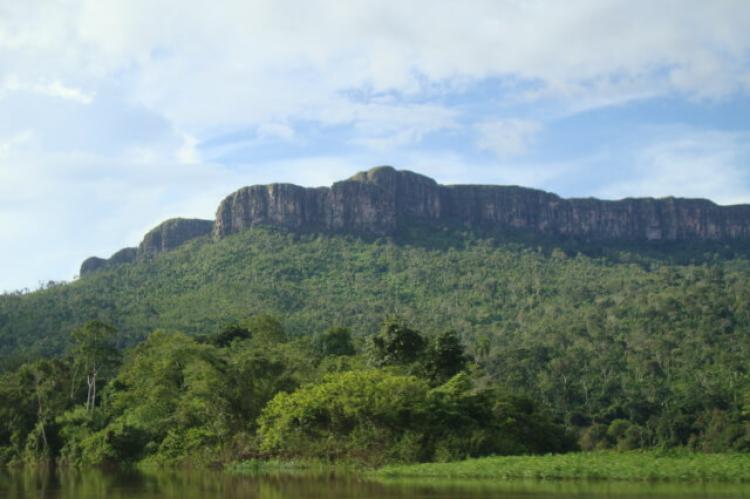Parima Tapirapecó: Preserving the Amazon’s Natural and Cultural Heritage
Located in the southeastern corner of Venezuela, Parima Tapirapecó National Park stands as one of the world's largest and most ecologically significant protected areas. This vast wilderness forms a critical part of the Guainan Highlands moist forests ecoregion, renowned for its rich biodiversity.
Parima Tapirapecó National Park: A Sanctuary of Biodiversity and Indigenous Heritage
Located in the southeastern corner of Venezuela, Parima Tapirapecó National Park stands as one of the world's largest and most ecologically significant protected areas. Established in 1991, this vast wilderness spans an impressive 38,290 square kilometers (14,780 square miles), forming a critical part of the Guainan Highlands moist forests ecoregion, renowned for its rich biodiversity. Beyond its natural splendor, the park is also a vital cultural landscape. It is home to the Indigenous Yanomami people, whose deep connection to the land reflects a centuries-old relationship with nature.
Geographical Overview
Parima Tapirapecó National Park lies within the Atabapo and Río Negro municipalities in Venezuela's southern state of Amazonas. Its diverse terrain, which includes the Sierra Parima Mountains, spans elevations ranging from 100 to 2,000 meters (300 to 6,500 feet) above sea level. This variation in altitude, coupled with the park's location in the humid tropics, supports a wide range of ecosystems, from lowland rainforests to montane cloud forests.
A key feature of the park is its role in safeguarding the headwaters of the Orinoco River, one of South America's largest rivers and a vital artery for the region's ecosystems. The Orinoco's origin within the park underscores Parima Tapirapecó's significance not just for Venezuela but for the broader environmental health of northern South America.
Biodiversity
Flora
The extraordinary range of habitats within Parima Tapirapecó National Park makes it one of the most biodiverse regions in the world. The park is home to an estimated 15% of Venezuela's known plant species, a testament to its ecological richness. Towering trees such as kapok and mahogany dominate the rainforest canopy, creating a vibrant and complex ecosystem that supports a wide variety of species beneath its lush foliage. Other notable plant species include orchids, bromeliads, and ferns, which thrive in the park's humid and cool climate.
Fauna
The park's extensive and varied landscapes provide refuge to a remarkable diversity of wildlife. Mammals such as capybaras, deer, and tapirs can be found grazing in the park's savannas and forests. Its rivers and lakes are teeming with aquatic life, including more than 300 fish species, caimans, and the elusive river dolphins.
Birdlife within Parima Tapirapecó is equally impressive, with notable species such as the harpy eagle, one of the world's most powerful birds of prey, the vividly colored toucan, and the hoatzin, a bird known for its distinctive appearance and unusual digestive system. The park's bird species make it a haven for birdwatchers and ecotourists alike, drawing nature enthusiasts from around the globe.
Indigenous Cultural Heritage
The Yanomami People
While Parima Tapirapecó National Park is a sanctuary for biodiversity, it is also home to the Yanomami, one of the Amazon's largest and most isolated Indigenous groups. The Yanomami have inhabited this region for centuries, relying on the park's abundant resources for survival and cultural practices. The Yanomami practice shifting agriculture, hunting, and fishing, living in harmony with the natural environment. Their deep spiritual connection to the land is expressed through their cosmology, rituals, and traditional knowledge passed down through generations.
Archaeological Sites
In addition to its living cultural heritage, the park contains significant archaeological sites dating back to pre-Columbian times. These sites offer valuable insights into the region's early inhabitants and their interaction with the environment. The artifacts at these sites highlight the long-standing relationship between humans and nature in this part of the Amazon Basin, further enriching the park's cultural and historical significance.
Conservation and Threats
Threats to Parima Tapirapecó National Park
Despite its protected status, Parima Tapirapecó National Park faces several significant threats. Illegal mining activities, particularly for gold, pose a serious risk to both the park's delicate ecosystems and the health of its Indigenous communities. Deforestation driven by illegal logging and land clearance for agriculture also threatens the park's biodiversity, while unsustainable tourism practices can lead to habitat degradation and disturbance to wildlife.
These threats have also adversely affected the Yanomami people. Illegal mining and deforestation encroach upon their traditional lands, disrupting their way of life and exposing them to external diseases and conflicts. Conservationists must strike a delicate balance between preserving the park's natural beauty and ensuring the well-being of its Indigenous inhabitants.
Conservation Efforts
Several conservation initiatives have been implemented to safeguard the park's natural and cultural heritage in response to these challenges. Both national and international organizations have worked to raise awareness about the importance of protecting Parima Tapirapecó's ecosystems and the rights of the Yanomami people. Sustainable tourism practices, which emphasize low-impact travel and cultural sensitivity, are also being promoted to generate income for local communities while minimizing environmental damage.
Conservationists stress the need for collaborative efforts that involve local communities in decision-making processes to ensure that the park's natural and cultural resources are preserved for future generations. Efforts to combat illegal mining and deforestation are ongoing, with increased government and NGO involvement to enforce regulations and protect this critical part of Venezuela's natural heritage.
Conclusion
Parima Tapirapecó National Park is a natural and cultural jewel in Venezuela's crown, offering unparalleled biodiversity and a profound connection to the Indigenous heritage of the Yanomami people. From its towering Sierra Parima Mountains to the headwaters of the Orinoco River, the park is an ecological treasure that continues to awe with its beauty and complexity. However, the park's future depends on ongoing conservation efforts to combat the threats of illegal mining, deforestation, and unsustainable tourism. With proper stewardship, Parima Tapirapecó can continue to serve as a sanctuary for its diverse ecosystems and the cultural legacy of its Indigenous inhabitants.
